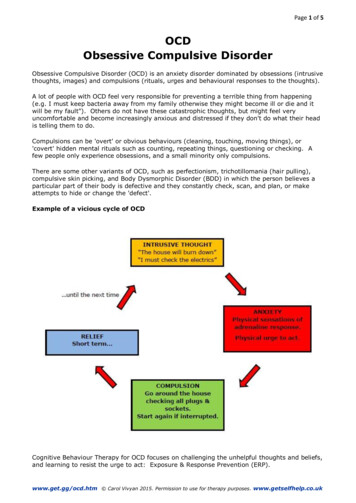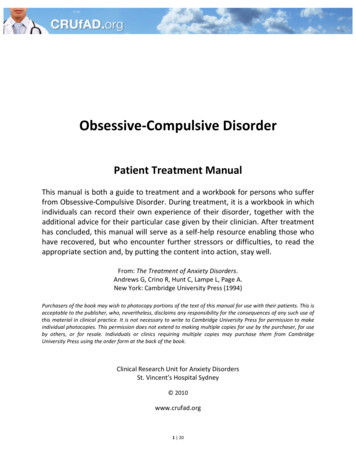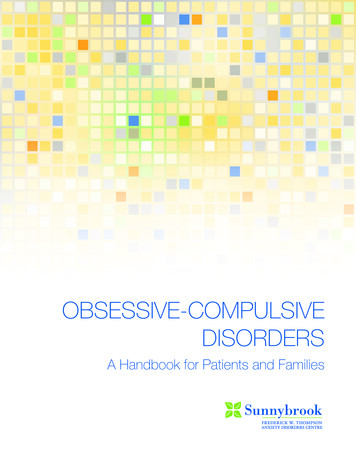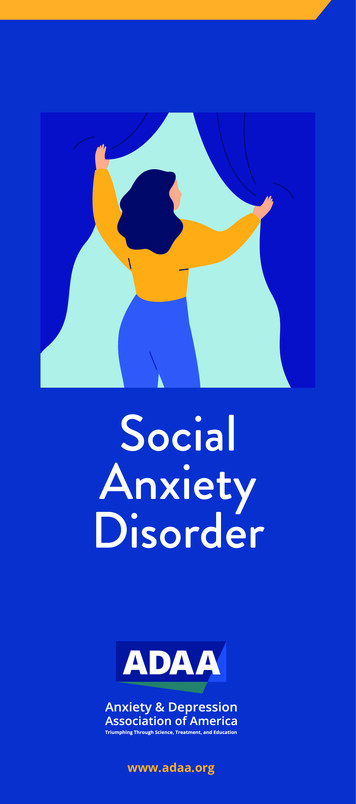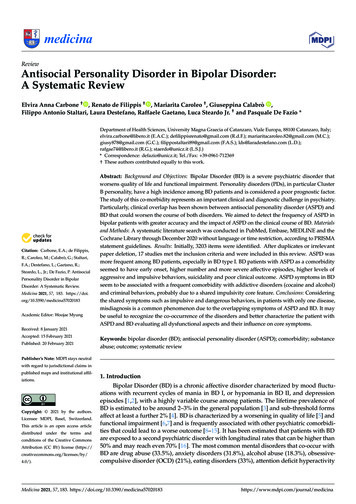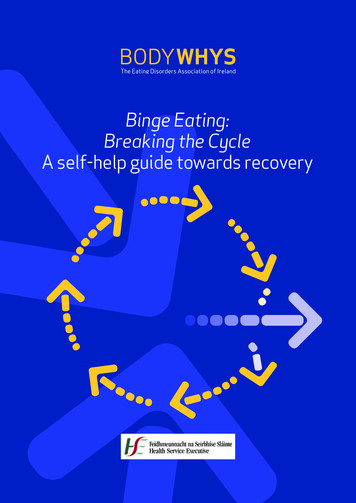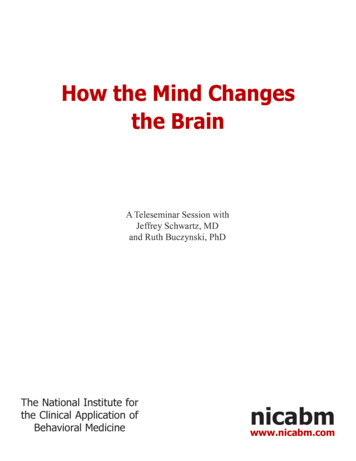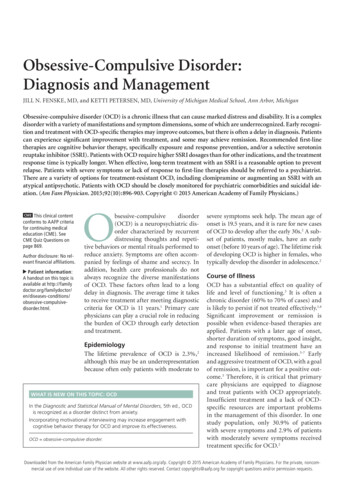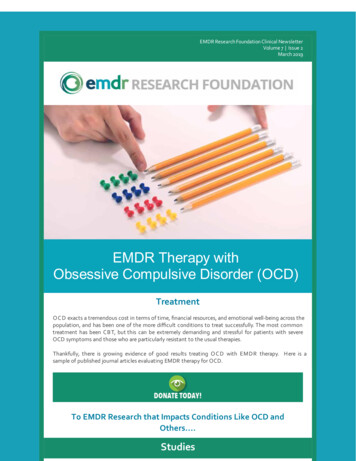
Transcription
EMDR Research Foundation Clinical NewsletterVolume 7 Issue 2March 2019EMDR Therapy withObsessive Compulsive Disorder (OCD)TreatmentO C D exacts a tremendous cost in terms of time, financial resources, and emotional well-being across thepopulation, and has been one of the more difficult conditions to treat successfully. The most commontreatment has been C B T, but this can be extremely demanding and stressful for patients with severeOCD symptoms and those who are particularly resistant to the usual therapies.Thankfully, there is growing evidence of good results treating O C D with EM D R therapy. Here is asample of published journal articles evaluating EMDR therapy for OCD.To EMDR Research that Impacts Conditions Like OCD andOthers.Studies
EMDR STUDYKennan, P., Farrell, D., Kennan, L., & Ingham, C.(2018, November). Treating obsessivecompulsive disorder (OCD) using eyemovement desensitisation and reprocessing(EMDR) therapy: An ethno-phenomenologicalcase series. International Journal ofPsychotherapy, 22, (3), 74-91ABSTRACT:O bsessive Compulsive Disorder (O C D) is a bio-psycho-socio-cultural disorder thatincludes genetic,neural brain anomalies, traumatic experiences, and development of dysfunctional beliefs frequentlylearnt from others and from the environment. Current empirical research supports Cognitive BehaviouralTherapy (Exposure and Response Prevention) as the 'gold-standard' psychological treatmentintervention. However, clients with O C D often describe their anxietiesas the result of an exposure toearlier adverse life experiences (past), or as a worst fear (future) related to their symptomatology, byonset or maintenance features. This case-series design study explored the impact of EM D R Therapy witheight clients diagnosed with O C D, yet despite having received previous treatment - C B T (ER P) - werestill O C D symptomatic. The researchmethodology was that of Ethno-Phenomenology. Psychometricresults highlighted a promising treatment effect of EM D R Therapy by reducinganxiety, depression,obsessions, compulsions and subjective levels of disturbance. Despite promising initial results with asmall survey, more conducted research with this important clinical population is essential.EMDR STUDYCusimano, A. (2018). EMDR in the treatment ofadolescent obsessive-compulsive disorder: Acase study. Journal of EMDR Practice andResearch, 12(4), 242-254. doi:10.1891/19333196.12.4.242.ABSTRACT:M o s t of the empirical evidence supporting the efficacy of eye movement desensitization andreprocessing (EM D R) has been with individualssuffering from posttraumatic stress disorder (PTSD). Thiscase study reports on the successful treatment of obsessive-compulsive disorder (O C D) in a 13-year-oldmale using the standard three-pronged approach of EM D R in a private practice setting. The currentprotocol addressed the initial touchstone event, the current level of distress related to that event, as wellas anticipation and planning for future feared events. The participant received 15 sessions of EM D R. At90-day posttreatment follow-up, there was a substantial decrease in O C D symptoms (from moderate tosubclinical) as measured by the Children's Yale-Brown O bsessive-CompulsiveScale, indicating a largeeffect size (d 0.81). The current study provides insight into treating OCD in adolescence and how usingt h e three-pronged approach (past, present, and future) of EM D R can be aneffective tool. Studylimitations and suggestions for future clinical research are discussed.
EMDR STUDYMarsden, Z., Lovell, K., Blore, D., Ali, S., &Delgadillo, J. (2018, January). A randomizedcontrolled trial comparing EMDR and CBT forobsessive-compulsive disorder. ClinicalPsychology and Psychotherapy, 5(1), e10-e18.doi:10.1002/cpp.2120ABSTRACT:Background: This study aimed to evaluate eye-movement desensitization and reprocessing (EM D R) as atreatment for obsessive-compulsive disorder (O C D), by comparison to cognitive behavioral therapy(CBT) based on exposure and response prevention.Method: This was a pragmatic, feasibility randomized controlled trial in which 55 participants with O C Dwere randomized to EM D R (n 29) or C B T (n 26).The Yale-Brown obsessive compulsive scale(Y B O C S) was completed at baseline, after treatment andat 6 months follow-up. Treatment completionand response rates were compared using chi-square tests. Effect size was examined using Cohen's d andmultilevel modelling.Results: O verall, 61.8% completed treatment and 30.2% attained reliable and clinically significantimprovement in OCD symptoms, with no significant differences between groups (p .05). There were nosignificant differences between groups in Y B O C S severity post-treatment (d -0.24, p .38) or at 6months follow-up (d -0.03, p .90).Conclusions: EMDR and CBT had comparable completion rates and clinical outcomes.EMDR STUDYMazzon, G.-P., Pozza, A., La Mela, C., &Fernandez, I. (2017, October). CBT combinedwith EMDR for resistant refractory obsessivecompulsive disorder: Report of three cases.Clinical Neuropsychiatry, 14(5), 345-356ABSTRACT:Objective: Cognitive-Behavioral Therapy (C B T) with Exposure and Response Prevention (ER P) is themost studied and empirically validated form of treatment for O bsessive-Compulsive Disorder (O C D).However, this therapeutic modality can be extremely demanding and stressful for many patients,especially those with severe O C D symptoms and those who are particularly resistant to the usualtherapies. Therefore, alternative forms of intervention - such as the Eye Movement Desensitization andReprocessing (EMDR) - are of great therapeutic interest.The present study describes a case series reporting how the processing of traumatic memories andobsessive contents can facilitate the treatment of symptoms in resistant cases with OCD.Method: Three cases have been described and analyzed in detail. Attention has been focused particularlyon how to enable patients to regulate their emotions, and on the treatment of sensations andcognitions associated with traumatic memories. A hybrid intervention, composed of EM D R and C B Ttherapies, was administered. This involved three distinct ways to use EM D R through andcombined withC B T in the psychotherapeutic treatment. Duringthe first phase of treatment with the first subject,EM D R was appliedto contents related to the patient's thoughts (obsessions of contamination), theresidential contact. The second patient (with obsessions of aggression) was treated with C B T and EM D Rfirst administered in a day-hospital facility and subsequently as an outpatient treatment; with the thirdpatient, EMDR was also administered as an outpatient, during a relapse prevention plan.Results: All three patients showed a clinically significant reduction in symptoms.
Conclusions: There are only three case reports so we can draw only anecdotal conclusions EM D R couldbe a useful method to implement current treatments when combined with C B T, also for O C D resistantpatients; however, future randomized controlled trials would be needed to validate these findings.EMDR STUDYPozza, A., Mazzoni, G. P., Neri. M. T., Bisciglia, R.,La Mela, C., Fernandez, I., & Dettore, D. (2014).Tackling trauma to overcome OCD resistance(The TTOOR Florence trial) Efficacy of EMDRplus CBT versus CBT alone for inpatients withresistant obsessive compulsive disorder.Protocol for a randomized comparativeoutcome trial.American Journal of AppliedPsychology, 2(5), 114-122. doi:10.12691/ajap-2-5-3.Researchers and clinicians have recently highlighted the usefulness of integrating additional therapeuticapproaches into standard intensive cognitive behavioral treatments (C B T) with the aim to improveclinical outcomes for patients with severe resistant O C D. To date, there is still a limited amount ofknowledge on the effectiveness of third-wave C B T techniquesfor O C D, despite such techniques seemedto be effective for a wide range of mental disorders. The Eyes Movement DesensitizationReprocessing(EM D R) is a treatment approach, based on the AdaptiveInformation Processing model, whichconceptualizes psychological disorders as manifestations of unresolved traumatic or distressingmemories. EM D R has been conceived as an integrative approach, aimed atfacilitating resolution ofmemories, desensitizing stimuli that trigger present distress as a consequence of second-orderconditioning, and incorporating adaptive attitudes and behaviors for better functioning. The presentpaper describes a research protocol for a randomized comparative outcome trial on inpatients withtreatment-resistant O C D in a tertiary inpatient clinic in Italy. The study will aim to: (a) examine theeffectiveness of EM D Rwith intensive brief C B T (EM D R C B T) compared to intensive brief C BaloneTonprimary outcomes (O C D symptoms, obsessive beliefs, depression,and anxiety) at immediate posttreatment, one-, six-month-, and one-year-follow-up; (b) compare feasibility and acceptability ofEM D R C B T protocol versus intensive brief C B T alone (interms of attrition and treatment satisfaction);(c) examine the effectiveness of EM D R C B T versus intensive brief C B T aloneon secondary outcomes(disgust propensity and sensitivity, emotion dysregulation, and dissociative experiences and symptoms).Inclusion/exclusion criteria of participants, outcomes, time scheduling, rationale, and therapeuticcomponents of the treatments will be presented.STUDYNijdam, M., Pol, M. V. D., Dekens, R., Olff, M., &Denys, D. (2013, January). Treatment of sexualtrauma dissolves contamination fear: Casereport. European Journal ofPsychotraumatology, 4, 19157.doi:10.3402/ejpt.v4i0.19157Background: In patients with co-morbid obsessive compulsive disorder (OCD) and posttraumatic stressdisorder (PTSD), repetitive behavior patterns,rituals, and compulsions may ward off anxiety and oftenfunction as a coping strategy to control reminders of traumatic events. Therefore, addressing thetraumatic event may be crucial for successful treatment of these symptoms.Objective: In this case report, we describe a patient with comorbid O C D and PTSD who underwentpharmacotherapy and psychotherapy.Methods: C ase Report. A 49-year-old Dutch man was treated for severe PTSD andmoderately severeOCD resulting from anal rape in his youth by an unknown adult man.Results: The patient was treated with paroxetine (60 mg), followed by nine psychotherapy sessions in
which eye movement desensitization and reprocessing (EM D R) and exposure and responseprevention(ER P) techniques were applied. During psychotherapy,remission of the PTSD symptoms precededremission of the OCD symptoms.Conclusions: This study supports the idea of a functional connection between PTSD and O C D.Successfully processing the trauma results in diminished anxiety associated with trauma reminders andsubsequently decreases the need for obsessive compulsive symptoms.EMDR STUDYMarr, J. (2012). EMDR treatment of obsessivecompulsive disorder: Preliminary research.Journal of EMDR Practice and Research, 6(1), 215. doi:10.1891/1933-3196.6.1.2T his article reports the results of two experiments, each investigating a different eye movementdesensitization and reprocessing (EM D R) protocol for obsessive-compulsive disorder(O C D) and eachwith two young adult male participants with long-standing unremitting O C D. Two adaptations ofShapiro's (2001) phobia protocol were developed, based on the theoretical view that O C D is a selfperpetuating disorder, with O C D compulsions and obsessions and current triggers reinforcing andmaintaining the disorder. Both adaptations begin by addressing current obsessions and compulsions,instead of working on past memories; one strategy delays the cognitive installation phase; the other usesmental video playback in the desensitization of triggers. The four participants received 14-16 one-hoursessions, with no assigned homework. They were assessed with the Yale-Brown O bsessive CompulsiveScale (Y-B O C S), with scores at pretreatment in the extreme range (mean 35.3). Symptomimprovement was reported by participants after 2 or 3 sessions. Scores at posttreatment were in thesubclinical/mild range for all participants (mean 8.5). Follow-up assessments were conducted at 4-6months, indicating maintenance of treatment effects (mean 7.5). Symptom reduction was 70.4% atposttreatment and 76.1% at follow-up for the Adapted EM D R PhobiaProtocol and 81.4% atposttreatment and at follow-up for the Adapted EM D R Phobia Protocol with Video Playback.Theoretical implications are discussed, and future research is recommended.EMDR STUDYNazari, H., Momeni, N., Jariani, M., & Tarrahi, M.J. (2011, November). Comparison of eyemovement desensitization and reprocessingwith citalopram in treatment of obsessivecompulsive disorder. International Journal ofPsychiatry in Clinical Practice, 15(4), 270-274.doi:10.3109/13651501.2011.590210Objective: O bsessive-compulsive disorder (O C D) is one of the chronic anxietydisorders that interferewith routine individual life, occupational and social functions. There is controversy about the first choiceo f treatment for O C D between medicationand psychotherapy. Aim. the aim was to investigate theefficacy of eye movement desensitization and reprocessing (EM D R) compared withmedication bycitalopram in treatment of OCD.Methods: This randomized controlled trial was carried out on 90 O C D patients that randomly wereassigned into two groups. They either received therapeutic sessions of EM D R or citalopram during 12weeks. Both groups blindly were evaluated by the Yale-Brown scale before and after the trial period.Results: Pretreatment average Yale-Brown score of citalopram group was about 25.26 as well as 24.83 in
EM D R group. The aftertreatment scores were 19.06 and 13.6, respectively. There was significantdifference between the mean Yale-Brown scores of the two groups after treatment and EM D R was moreeffective than citalopram in improvement of OCD signs.Conclusion: It is concluded that although both therapeutic methods (EM D R andCitalopram) hadsignificant effect in improving obsessive signs but it seems that in short term EM D R has better effect inimprovement of final outcome of OCD.More InformationYou'll find information about case conceptualization and treatment planning in the treatment of O C Dwith EM D R therapy's standard protocol integrated withstandard C B T treatment for O C D in:Böhm, K.(2016). O bsessive-compulsive disorder and EM D R therapy. In M. Luber (Ed.),E y e movementdesensitization and reprocessing (EM DR) therapy scriptedprotocols and summary sheets:Treating anxiety, obsessive-compulsive, and mood-related conditions (pp. 102-136). New York, NY:Springer Publishing Co.What's New?NEW for Clinicians, Consultants, andResearchers!EMDR Fidelity Rating Scale (Version2)Deborah L. Korn, Psy.D.Louise Maxfield, Ph.D.Robert Stickgold, Ph.D. MediNancy J. Smyth, Ph.D.See the new EMDR Fidelity Rating ScaleNewly Released International Societyfor Traumatic Stress Studies' PTSDguidelines.EMDR therapy was given astrong recommendation for thetreatment of PTSD in adults andchildren.The new International Society forTraumatic Stress Studies' guidelines onthe prevention and treatment of posttraumatic stress disorder (PTSD), and position papers on complex PTSD, have recently beenpublished. An international committee of experts was established in 2015 to updateguidelines published in 2009 by reviewing the latest evidence from clinical researchtrials. The guidelines and position papers are intended to assist clinicians providingprevention and treatment interventions for children, adolescents and adults with, or at riskof, developing PTSD and Complex PTSD. Professor Julian Ford, ISTSS President, said, "Theexcellent work of the ISTSS Treatment Guidelines Committee will make a real difference topeople affected by traumatic events" The new guidelines and position papers are availableto download from the ISTSS website.Click Here For More Information
CREATE A FUNDRAISING PAGE!You have the opportunity to create afundraising page in which your network caneasily donate to the EMDR ResearchFoundation in honor of a family member,friend, colleague, yourself, or through aspecial event or occasion like a wedding,graduation, or running in a5K race!More Details on Creating a Fundraising PageSEE OUR UPDATED TOOLKIT!EMDR Early Intervention and CrisisResponse: Researcher's ToolkitVersion 03.2018 2014-2018Rosalie Thomas, Ph.D., R.N. withformatting/design work by Katy Murray,MSW, LICSWView Our New Researcher's ToolkitAs Seen on our WebsiteNEWSLETTER ARCHIVESFor a complete listMilitary-In-Action NewslettersClinical Newslettersplease visit our website.You, as always, are invaluable in this endeavor!EMDR Research Foundationhttps://emdrresearchfoundation.org info@emdrresearchfoundation.org630-296-4399CONNECT WITH EMDR RESEARCH FOUNDATION ON SOCIAL MEDIA
EMDR Research Foundation Clinical Newsletter Volume 7 Issue 2 March 2019 EMDR Therapy with Obsessive Compulsive Disorder (OCD) Treatment OCD exacts a tremendous cost in terms of time
